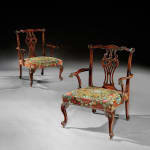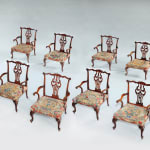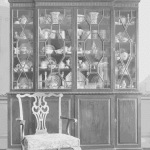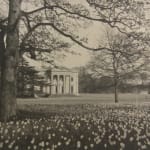Seating
THE SPETCHLEY PARK SUITE OF EIGHT GEORGE II MAHOGANY ARMCHAIRS
W: 70.5 cm
D: 68.6 cm
Further images
Provenance
Suite of eight supplied to Robert Berkeley (1713-1804) of Spetchley Park, Worcestershire; thence by descent
Sold as four pairs, Sotheby’s London, 11 December 2019, lots 47-50, GBP 100,000, 62,500, 143,750, 118,750
Important Private Collection: West Coast, USA
Publications
One of the armchairs photographed in the Drawing Room, ‘Spetchley Park - I. Worcestershire, The Seat of Mr. R. V. Berkeley’, Country Life (8 July 1916), p. 46
An Important Suite of Eight George II Mahogany Armchairs, retaining their original needlework upholstery.
Possibly by Thomas Chippendale, or aworkshop strongly associated with him.
Overview and Significance
This distinguished suite of eight mahogany armchairs represents the highest echelon of mid-18th century English cabinetmaking. Each chair retains its original hand-stitched needlework seat cover — a survival of extraordinary rarity. Worked in wool on canvas, each seat is individually designed, reflecting the bespoke nature of high-status upholstery commissions in the 1750s.
The covers exhibit a dazzling array of Rococo imagery: stylised foliage, flowering urns, fantastical birds, and baroque scrollwork — all rendered in a vivid palette of reds, greens, golds, and blues. Their survival attests not only to the quality of materials but also to the reverence with which these chairs have been preserved for over two centuries.
Design Context: The Influence of Chippendale’s Director
The form and detailing of the chairs align closely with designs published in Thomas Chippendale’s The Gentleman and Cabinet-Maker’s Director (1754; expanded 1755 and 1762) — the most influential pattern book of English furniture design in the 18th century. The Director codified emerging “modern” styles — Rococo, Gothic, and Chinese — and provided a new design vocabulary that shaped English taste for decades.
Carving and Stylistic Features
The present chairs are deeply indebted to this idiom. Their sinuous serpentine crests, crisply carved C-scrolls, and foliate clasps exemplify Chippendale’s Rococo vocabulary. Of particular note are the pierced splats, which blend organic Rococo scrolls with pointed Gothic tracery — drawing directly on Plates XIII–XV of the Director, which illustrate Gothic chair backs.
The carved “nibs” of the C-scrolls curl outward like stylised crockets, further heightening the Gothic allusion — a synthesis of ornament and architecture characteristic of Chippendale’s most original designs.
Structure and Craftsmanship
The chairs’ structural form — generous square seats, shaped arms, and pronounced cabriole legs terminating in tightly scrolled toes — mirrors the robust and sculptural aesthetic favoured by Chippendale and his circle. While no label or invoice survives to confirm authorship, the exceptional quality of carving and design suggests production in a leading London workshop well-versed in Chippendale’s designs, and perhaps employing craftsmen from his St. Martin’s Lane circle.
Commission and Provenance
The suite was likely commissioned by Robert Berkeley (1713–1804) shortly after inheriting Spetchley Park, Worcestershire in 1756. A politically active Catholic gentleman and noted patron, Berkeley undertook major improvements to the house, including remodelling the Dining Room in the Adam style. These chairs were almost certainly created during this campaign.
That Berkeley owned a copy of Chippendale’s 1754 Director is highly suggestive, placing him among the progressive patrons of English Rococo design. Whether the suite was made by Chippendale’s own workshop or by a talented rival, it clearly reflects the cultural and stylistic aspirations of an elite English patron.
Later History and Rarity
The suite remained at Spetchley Park until the mid-20th century, recorded in the 1893 inventory and again in 1949, when they were valued at £2,000 — the highest single valuation given to any object in the house. Their historical provenance, exceptional design pedigree, and the survival of the original needlework upholstery place this suite among the most significant examples of English Rococo seat furniture known today.









